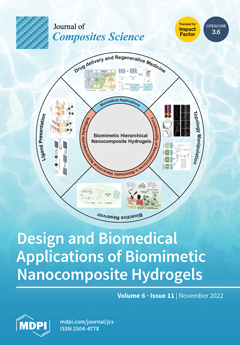High performance lightweight structures made of metal matrix composites (MMCs) are in demand for application in variety of industries such as aircraft, spacecraft, automobile, marine, sports equipment, etc. However, uniform distribution of the reinforcement phase to improve the mechanical properties and quality of
[...] Read more.
High performance lightweight structures made of metal matrix composites (MMCs) are in demand for application in variety of industries such as aircraft, spacecraft, automobile, marine, sports equipment, etc. However, uniform distribution of the reinforcement phase to improve the mechanical properties and quality of MMCs has been the challenge for the manufacturing industries. Hence, researchers are focusing on the development of traditional low-cost method of producing metal matrix composites. In the view of above facts, an attempt is made to study the processing and characterization of Si-Al alloy reinforced with zirconium dioxide particulate composites in this paper. Hence, this paper concentrates on experimentally identifying the effect of stir cast and spray forming processing techniques followed by hot pressing on micro hardness, compressive strength, and tensile strength using Taguchi’s design of experiments for aluminum silicon matrix alloy reinforced with zirconium dioxide particulates. From the extensive experimentation on aluminum and silicon reinforced with the ZrO
2 powder particulates, it was observed that there was an improvement in selected mechanical properties as the percentage of ZrO
2 increased with 13 wt.% of silicon under spray forming processing technique compared to stir cast composites. This may be due to uniform distribution homogenous dispersion, larger work hardening rate, and structure of dislocation tangles around the ZrO
2 particulates that occurred during spray forming processing technique. Further, results obtained from the interaction plot, contour plot, main effects plot, and analysis of variance (ANOVA) proved to be successful for identifying the optimum processing parameters for Si-Al alloy reinforced with zirconium dioxide particulate composites. Further, this paper also discusses wear study using pin on disc wear testing apparatus on spray forming processed aluminum and silicon (13.0 wt.%) alloy reinforced with the ZrO
2 powder particulates based on Taguchi’s design of experiments followed by second order model generation for wear using response surface methodology. Finally, electrode wear study of spray forming processed aluminum and silicon alloy reinforced with the ZrO
2 powder particulates using electric discharge machining by varying peak current (A), pulse on time (μs), and pulse off time (μs) using brass, copper, and graphite as electrode material based on L
27orthogonal array. The understanding gained from the design of experiments in this paper can be used to develop future guidelines for processing and characterization of Si-Al alloy reinforced with zirconium dioxide particulate composites.
Full article





